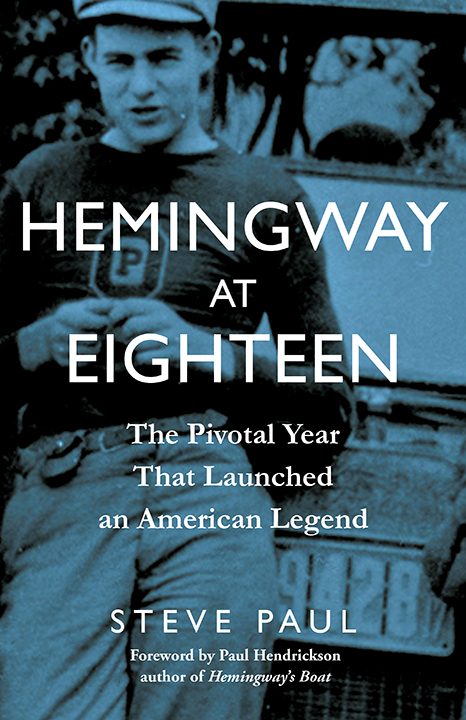
HEMINGWAY AT EIGHTEEN
The Pivotal Year That Launched an American Legend
In the summer of 1917, Ernest Hemingway was an eighteen-year-old high school graduate unsure of his future. The American entry into the Great War stirred thoughts of joining the army. While many of his friends in Oak Park, Illinois, were heading to college, Hemingway couldn’t make up his mind and eventually chose to begin a career in writing and journalism at the Kansas City Star, one of the great newspapers of its day.
In six and a half months at the Star, Hemingway experienced a compressed, streetwise alternative to a college education that opened his eyes to urban violence,
In the summer of 1917, Ernest Hemingway was an eighteen-year-old high school graduate unsure of his future. The American entry into the Great War stirred thoughts of joining the army. While many of his friends in Oak Park, Illinois, were heading to college, Hemingway couldn’t make up his mind and eventually chose to begin a career in writing and journalism at the Kansas City Star, one of the great newspapers of its day.
In six and a half months at the Star, Hemingway experienced a compressed, streetwise alternative to a college education that opened his eyes to urban violence, the power of literature, the hard work of writing, and a constantly swirling stage of human comedy and drama. The Kansas City experience led Hemingway into the Red Cross ambulance service in Italy, where, two weeks before his nineteenth birthday, he was dangerously wounded at the front.
Award-winning writer Steve Paul takes a measure of this pivotal year when Hemingway’s self-invention and transformation began—from a “modest, rather shy and diffident boy” to a confident writer who aimed to find and record the truth throughout his life. Hemingway at Eighteen provides a fresh perspective on Hemingway’s writing, sheds new light on this young man bound for greatness, and introduces anew a legendary American writer at the very beginning of his journey.
- Chicago Review Press
- Hardcover
- October 2017
- 256 Pages
- 1613739710
About Steve Paul
 Steve Paul is an award-winning writer and editor who worked at the Kansas City Star for more than 40 years, including stints as book critic, arts editor, restaurant critic, and—before his retirement in early 2016—editorial page editor. He is a former board member of the National Book Critics Circle and the author (and photographer) of Architecture A to Z, the editor of Kansas City Noir, and coeditor of War + Ink: New Perspectives on Ernest Hemingway’s Early Life and Writings.
Steve Paul is an award-winning writer and editor who worked at the Kansas City Star for more than 40 years, including stints as book critic, arts editor, restaurant critic, and—before his retirement in early 2016—editorial page editor. He is a former board member of the National Book Critics Circle and the author (and photographer) of Architecture A to Z, the editor of Kansas City Noir, and coeditor of War + Ink: New Perspectives on Ernest Hemingway’s Early Life and Writings.
Praise
“A clear, concise, sympathetic account of a gifted young man discovering who he is—and what he can do.”—Kirkus
“Do we need another Hemingway biography? Absolutely, if it’s as intelligent, insightful, and big hearted as Hemingway at Eighteen. This is a Hemingway few of us know—dazzlingly talented but still young, pulsing with ambition, and searching for his place in the literary world. Steve Paul has given us the origins of a legend.”—Candice Millard, author of The River of Doubt: Theodore Roosevelt’s Darkest Journey
“A remarkably fine, absolutely illuminating book.”—Scott Donaldson, author of Hemingway vs. Fitzgerald: The Rise and Fall of a Literary Friendship
Discussion Questions
1. Ernest Hemingway graduated from high school about two months after the United States committed to entering the war in Europe. How did the war shape the young man’s experience of the next year?
2. What were some qualities of newspaper journalism that seemed to appeal to the young Hemingway and which, in turn, he thrived on?
3. Kansas City, where Hemingway began his writing career, was something of a mini-Chicago. What kinds of sin and corruption did Hemingway find there?
4. Hemingway was mentored by stern newspapermen and boisterous staffers. What are some of the most important things about writing that he learned at The Kansas City Star?
5. Hemingway’s Kansas City friend Ted Brumback had driven ambulances in France and influenced the young reporter’s decision to sign up for the ambulance service in Italy. Describe Hemingway’s month-long experience in the ambulance corps.
6. Although Hemingway served the war in a non-combatant role, his experience on the front lines exposed him to soldiering in a deep way. What happened on July 8, 1918, and how did it affect his life and writing?
7. At several points in this “pivotal year” Hemingway seemed to turn moments of experience into boastful myths. Describe one of those Hemingway tales and how it might have fit into the character of one of the most dominant American writers of the 20th century.
